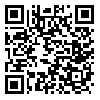دوره 10، شماره 20 - ( 9-1399 )
جلد 10 شماره 20 صفحات 44-31 |
برگشت به فهرست نسخه ها
Download citation:
BibTeX | RIS | EndNote | Medlars | ProCite | Reference Manager | RefWorks
Send citation to:



BibTeX | RIS | EndNote | Medlars | ProCite | Reference Manager | RefWorks
Send citation to:
Nazarpouri S, Bahram A. The Relationship between Movement Motivation and Motor Development in Infants with and without Experience of Kindergarten. JRSM 2020; 10 (20) :31-44
URL: http://jrsm.khu.ac.ir/article-1-2479-fa.html
URL: http://jrsm.khu.ac.ir/article-1-2479-fa.html
نظرپوری شهرام، بهرام عباس. ارتباط بین انگیزشحرکتی و رشد حرکتی در اطفال دارا و بدون تجربۀ مهدکودک. پژوهش در مدیریت ورزشی و رفتار حرکتی. 1399; 10 (20) :31-44
1- دانشگاه لرستان ، snazarpouri@yahoo.com
2- دانشگاه خوارزمی
2- دانشگاه خوارزمی
چکیده: (7085 مشاهده)
هدف پژوهش حاضر، تعیین ارتباط بین انگیزشحرکتی و رشد حرکتی در اطفال دارا و بدون تجربۀ مهدکودک بود. جامعۀ آماری این پژوهش، شامل کلیۀ والدین دارای اطفال پسر 10 الی 11 ماهۀ شهر تهران بود که از بین آنان 150 طفل دارا و 150 طفل بدون تجربۀ مهدکودک، به روش نمونهگیری تصادفی چندمرحلهایی به عنوان نمونه انتخاب شدند. ابزار گردآوری اطلاعات شامل؛ پرسشنامۀ انگیزشحرکتی اطفال، و مقیاس رشدحرکتی پیبادی ویراش دوم (PDMS-2)، بود. تحلیل دادهها با استفاده از آزمونهای ضریب همبستگی پیرسون، آزمون رگرسیون خطی و آزمونt مستقل، در سطح معنیداری 05/0≥ P، انجام شد. نتایج ارتباط مثبت و معنیداری )000/0= (P، را بین انگیزشحرکتی و رشدحرکتی در اطفال دارا و بدون تجربۀ مهدکودک، نشان داد. از طرفی، تفاوت بین میزان انگیزشحرکتی و رشدحرکتی اطفال دارا و بدون تجربۀ مهدکودک، معنیدار )000/0= (Pو اطفال بدون تجربۀ مهدکودک، انگیزشحرکتی و رشدحرکتی بالاتری داشتند. این نتایج نشان میدهد که نگهداری و مراقبت اطفال در مراکز مهدکودک ممکن است بهعلت ضعف برنامه ها و امکانات اثرات منفی بر انگیزشحرکتی و میزان رشدحرکتی آنان داشته باشد.
نوع مطالعه: كاربردي |
موضوع مقاله:
رفتار حرکتی
دریافت: 1396/2/18 | پذیرش: 1396/5/11 | انتشار الکترونیک پیش از انتشار نهایی: 1399/8/3 | انتشار: 1399/9/10
دریافت: 1396/2/18 | پذیرش: 1396/5/11 | انتشار الکترونیک پیش از انتشار نهایی: 1399/8/3 | انتشار: 1399/9/10
فهرست منابع
1. Gallahue DL , Ozmun GC, Goodway JD. Understanding Motor Development: Infants, Children, Adolescents, Adults. 7th Edition, Kindle Edition. 2012.
2. Payne VG, Isaacs LD. Human Motor Development a Lifespan Approach. Eight Edition, McGraw-Hill Higher Education. 2012.
3. Atun-Einy O, Berger SE, Scher A. Assessing motivation to move and its relationship to motor development in infancy. Infant Behavior and Development, 2013; 36(3), 457-469. [DOI:10.1016/j.infbeh.2013.03.006]
4. Abdoli B. Psychosocial foundations of physical education and sports. Tehran, Bamdad Ketab Publications, 2005. In Persian.
5. Thelen, E. Dynamic systems theory and the complexity of change. Psychoanalytic Dialogues: 15., 255-283. 2005. [DOI:10.1080/10481881509348831]
6. Von Hosteen C. Action in development. Developmental Science: 10. 54-60. 2007. [DOI:10.1111/j.1467-7687.2007.00564.x]
7. Berger SE, Adolph KE, Lobo SA. Out of the toolbox: Toddlers differentiate wobbly and wooden handrails. Child Development: 2005. 76., 1294-1307. [DOI:10.1111/j.1467-8624.2005.00851.x]
8. Khalaji H. Investigating the relationship between anthropometric characteristics and motor performance of 6 to 8-year-old students with experience and without experience in Arak Kindergarten (2004-2005 academic year), Peyk Noor: 2004. No. 4 (3): 18-30. In Persian.
9. Loovis EM, Butterfield SA. Relationship of hand length to catching performance by children in kindergarten to grade 2. Perceptual and motor skills. 2003 Jun;96(3_suppl):1194-6. [DOI:10.2466/pms.2003.96.3c.1194]
10. Weikartr D. A cooparative study of the preschool: curriculum,in C.seefeld(Ed). The Early childhood curriculum New arm armicha university. 1969. pp:20-29.
11. Zigler E, Valentine J. Project Head Start: A legacy of the war on poverty. 1979.
12. Housden T, Kam R. Full-Day Kindergarten: A Summary of the Research.1992.
13. Lemos AG, Avigo EL, Barela JA. Physical education in kindergarten promotes fundamental motor skill development. Advances in Physical Education. 2012 Feb 16;2(01):17. [DOI:10.4236/ape.2012.21003]
14. Chaves R, Baxter-Jones A, Gomes T, Souza M, Pereira S, Maia J. Effects of individual and school-level characteristics on a child's gross motor coordination development. International journal of environmental research and public health. 2015 Aug;12(8):8883-96. [DOI:10.3390/ijerph120808883]
15. Doralp S, Bartlett D. Infant Movement Motivation Questionnaire: Development of a measure evaluating infant characteristics relating to motor development in the first year of life. Infant Behavior and Development. 2014 Aug 1;37(3):326-33. [DOI:10.1016/j.infbeh.2014.04.002]
16. Provost B, Heimerl S, McClain C, Kim NH, Lopez BR, Kodituwakku P. Concurrent validity of the Bayley Scales of Infant Development II Motor Scale and the Peabody Developmental Motor Scales-2 in children with developmental delays. Pediatric Physical Therapy. 2004 Oct 1;16(3):149-56. [DOI:10.1097/01.PEP.0000136005.41585.FE]
17. Rahmaniresa A. Determination of Peabody Development Motor Scale (PDMS) validity and reliability in 0-2 year-old infants of Tehran. Master of sciences dissertation, University of Welfare and Rehabilitation Sciences. 2008.
18. Farsi A, Abdoli B, Kaviani M, Kaviani A (2010). The effect of perceptual-motor experience on the motor development benefit of large and fine movements of 5-8 months old infants. Growth and learning of motor-sports- No. 5- P.: 84-71. In Persian.
19. Shirley MM. The First Two Years. Vol. I, Postural and Locomotor Development; Vol. II, Intellectual Development; Vol. III, Personality Manifestations.1931.
20. Adolph KE, Cole WG, Komati M, Garciaguirre JS, Badaly D, Lingeman JM, Chan GL, Sotsky RB. How do you learn to walk? Thousands of steps and dozens of falls per day. Psychological science. 2012 Nov;23(11):1387-94. [DOI:10.1177/0956797612446346]
21. Gibson EJ, Pick AD. An ecological approach to perceptual learning and development. Oxford University Press, USA; 2000. [DOI:10.1207/S15326969ECO1204_04]
22. Newman BM, Newman PR. Development through life: A psychosocial approach. Cengage Learning; 2017. Apr 12.
23. Winders PC. The goal and opportunity of physical therapy for children with Down syndrome. 2011.
ارسال پیام به نویسنده مسئول
| بازنشر اطلاعات | |
 | این مقاله تحت شرایط Creative Commons Attribution-NonCommercial 4.0 International License قابل بازنشر است. |








